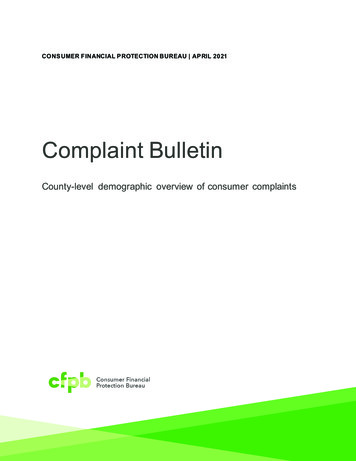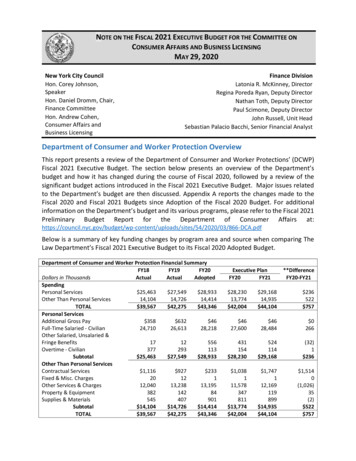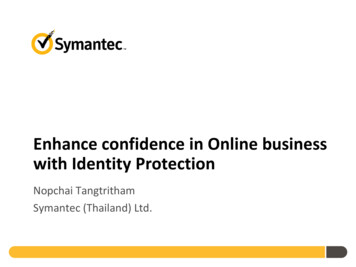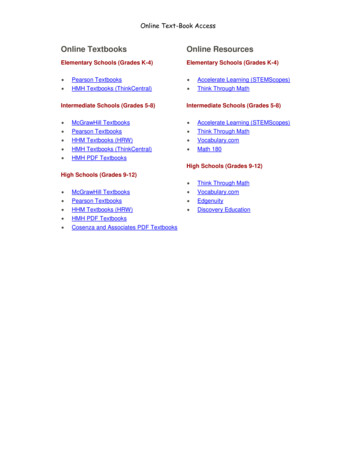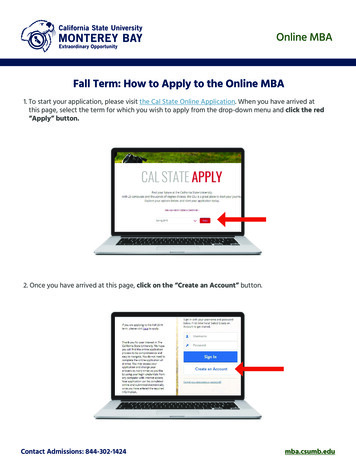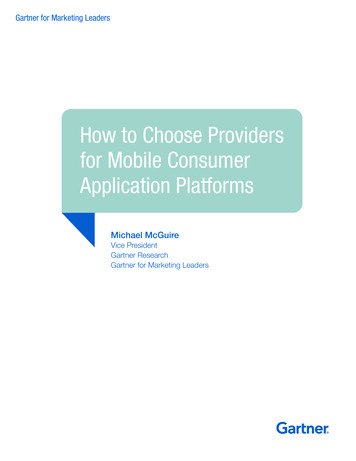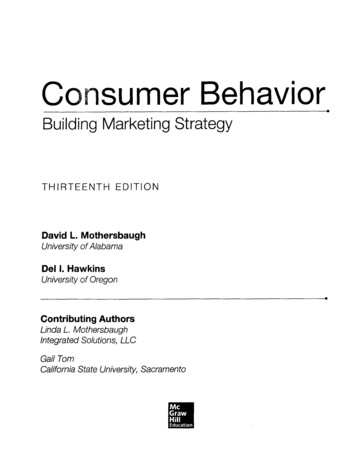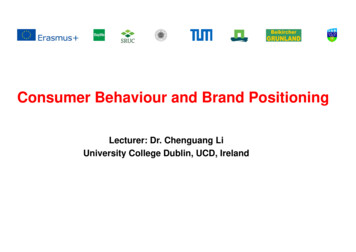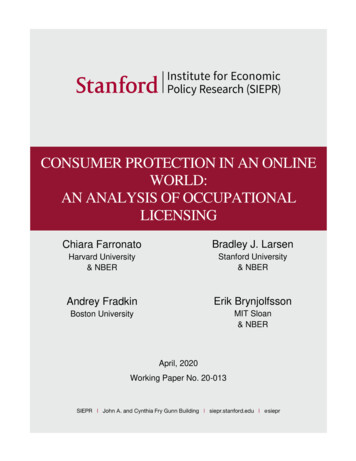
Transcription
CONSUMER PROTECTION IN AN ONLINEWORLD:AN ANALYSIS OF OCCUPATIONALLICENSINGChiara FarronatoBradley J. LarsenHarvard University& NBERStanford University& NBERAndrey FradkinErik BrynjolfssonBoston UniversityMIT Sloan& NBERApril, 2020Working Paper No. 20-013
Consumer Protection in an Online World:An Analysis of Occupational Licensing Chiara Farronato† Andrey Fradkin‡ Bradley J. Larsen§ Erik Brynjolfsson¶March 20, 2020AbstractWe study the effects of occupational licensing on consumer choices and market outcomes in a large online platform for home improvement services. Exploiting exogenousvariation in the time licenses are displayed on the platform, we find that platformverified licensing status is unimportant for consumer decisions relative to review ratingsand prices. We confirm this result in an independent consumer survey. Licensing restrictions differ widely by state, and persist despite the growing potential of onlinereputation to reduce information asymmetries. More stringent regulations are associated with less competition, higher prices, and no improvement in consumer satisfactionfor transactions on the platform. We thank Stone Bailey, Felipe Kup, Ziao Ju, Rebecca Li, Jessica Liu, Ian Meeker, Hirotaka Miura,Michael Pollmann, Nitish Vaidyanathan, and Chuan Yu for outstanding research assistance. We thankthe company employees for sharing data and insights and participants at ASSA 2018, Boston University,Collegio Carlo Alberto, FTC Microeconomics Conference, INFORMS Revenue Management and PricingConference, Institute for Industrial Research Stockholm, Lehigh University, NBER PRIT 2019 SummerMeetings, Marketing Science Conference, Platform Strategy Research Symposium, SITE 2019 OccupationalLicensing Conference, SOLE 2019, WISE 2018, ZEW ICT, and 2020 NBER Labor Economics Winter Meetings for comments. We acknowledge support from grants through the Hellman Foundation, the Laura andJohn Arnold Foundation, the Russell Sage Foundation, and the MIT Initiative on the Digital Economy.†Harvard University and NBER, cfarronato@hbs.edu‡Boston University, fradkin@bu.edu§Stanford University, Department of Economics and NBER, bjlarsen@stanford.edu¶MIT Sloan and NBER, erikb@mit.edu
1IntroductionHeated debates over the effects of occupational licensing date back hundreds of years, with along treatise on the subject contained in The Wealth of Nations (Smith 1776), and continueintensely today.1 An occupational license is a restriction placed on who is allowed to performcertain types of services, requiring that practitioners meet licensing requirements in orderto legally practice. These laws apply to a growing share of the US labor force and now affectnearly 30% of all workers. Over 1,100 occupations are licensed in at least one state (Kleinerand Krueger 2010). These occupations include electricians, contractors, interior designers,and even hair salon shampoo specialists. The stringency of the licensing requirements—andthe range of specific tasks within a service category requiring or not requiring a license—varies widely from state to state. Furthermore, these regulations have not changed inresponse to the spread of digital platforms and reputation systems, which may reduceasymmetric information and moral hazard. This paper takes a first step at examining therole played by digital markets and online reputation in relation to labor market licensingregulations.There is limited empirical evidence on the effects of licensing restrictions on professionals,consumers, and market equilibrium. In the presence of information asymmetries, licensingmay protect consumers from poor service outcomes, guaranteeing at least some minimumstandards of quality and safety for consumers (as in the model of Leland 1979). On the otherhand, these laws may raise consumer prices and increase rents for licensed professionals byrestricting competition (as in the model of Pagliero 2011). The model of Shapiro (1986)demonstrates that the benefits of occupational licensing for some consumers may come atcosts to other consumers who face higher prices due to licensing.We study the magnitude of these costs and benefits using new data from a large onlinelabor market where consumers can hire professionals for home improvement services. Wefirst demonstrate, using choice data, that consumers care greatly about the professional’sprice and online rating but care little about the professional’s licensing status. We validatethese results in a nationwide survey of consumers who recently bought home improvement1See, for example, discussions in the New York Times (Cohen 2016), Wall Street Journal (Zumbrun2016), and Forbes (Millsap 2017).1
services. We then combine our platform data with codified occupational licensing regulations to find that more stringent licensing regimes do not improve transaction quality asmeasured by review ratings or the propensity of consumers to use the platform again. Bothof these results suggest that the benefits of licensing in terms of service quality are not large.On the cost side, we find that more stringent licensing regimes result in less competitionand higher prices.The platform we study works as follows. A consumer can post a request for a particularjob. Professionals respond to this request with a quote. For each quote, the consumercan see the proposed price, measures of the professional’s online reputation (such as a 1–5star average rating from past customers and the number of reviews), as well as a badgeindicating that the professional is licensed. This badge is only displayed if the professionalhas uploaded proof of licensure to the platform and after the platform has independentlyverified this information, which typically occurs with a time lag. Depending on the specificproject needs or the required professional qualifications, a service provider may need alicense in some jurisdictions but not others.This paper is the first of which we are aware to study occupational licensing throughlarge-scale micro data on both supply and demand. The data consists of over one millionrequests by consumers in many distinct service categories throughout the United States forover eight months.2 It comes directly from the company’s databases, and allows visibilityinto most dimensions of the search and exchange process occurring through the platform. Aparticularly novel feature of the data is that it simultaneously contains information on prices,labor supply, and quality (consumer satisfaction)—a rarity in the occupational licensingliterature. We review this literature in section 2 and discuss the data and institutionalsetting in section 3.In section 4 we analyze how consumers’ decisions depend on the characteristics of professionals (their verified licensing status and online reputation) and their price quotes. Webegin with timing-based estimates that analyze a consumer’s probability of hiring a professional surrounding the exact date on which the professional’s uploaded licensing status isverified by the platform. We exploit a unique feature of our data that allows us to identify2The exact number of requests, the actual time frame, and the name of the company are not revealed toprotect company’s confidential information.2
the causal effect on consumers’ decisions from displaying the professional’s verified licensingstatus. Professionals choose to upload proof of licensure, but this information is not displayed to consumers until a few days later when the platform verifies the licensure. In thedata, we see the timestamp for the original uploading of licensure proof by the professionaland the timestamp for the platform’s verification. We use this variation in timing for ourestimates and find no statistically significant change in the probability that a consumerhires a professional before vs. after the verification is posted. In contrast, we find a discontinuous positive jump in the probability of hiring a professional following the first time thata professional receives a review, suggesting that consumers respond to online reputationcharacteristics of professionals and not to indicators of licensure. We also examine whether,around the time of their license verification or first review, professionals themselves changetheir behavior in terms of prices they charge or types of requests on which they bid, andwe find little evidence of changes in the composition of bids that professionals submit.We then analyze consumer choices in a regression framework, where we regress consumers’ choices to hire a given professional on an indicator for whether the professional hasa verified licensing status, controlling for whether the professional has uploaded licensureproof, again allowing us to obtain the causal effect of the verified licensing signal. We alsocontrol for price and online reputation measures (average star rating and the number ofprevious reviews). These variables may be correlated with unobservable characteristics ofthe job request and the professionals’ quality. We address this concern through a numberof additional bid-level controls, request-level fixed effects, and a novel instrumental variables strategy. In our regression framework, we find similar results to our timing-basedestimates: consumers appear to place weight on professionals’ reputation and prices butnot on professionals’ licensing status.In section 5, we present the results of an original survey we conducted using a nationallyrepresentative panel of individuals who purchased a home improvement service within thepast year. We find that the survey respondents typically think of prices and reputation—signaled through word of mouth or online reviews—as the primary factors influencing theirdecision to hire a particular professional. In contrast, fewer than 1% of these respondentsmention licensing status among the top 3 reasons for why they hired a given service pro-3
fessional. This provides further evidence that consumers may care more about prices andonline reputation than licensing status. We also find evidence that consumers do not simplybelieve that all professionals are licensed. We asked survey respondents whether they knewthe licensing status of the professional they ended up hiring. Only 61% of consumers weresure that their service provider was licensed and, of those, a majority only found out whenthey signed their contract rather than during their search, suggesting that most consumersare not particularly knowledgeable of professionals’ licensing at the time of their hiringdecision.These results—that consumers appear to pay little attention to licensing—suggest that,from the consumer’s perspective, current licensing requirements may add little value.3 Insection 6 we consider the effects of these laws on supply and demand (consumer requests, labor supply, prices, and consumer satisfaction). We use the large heterogeneity in regulatorystringency across occupations and states to measure the effect of licensing regulation—rather than the effect of licensing signals—on market equilibrium outcomes. To do this,we combine information from Carpenter et al. (2017) with additional data we collected tocreate a measure of licensing stringency at the level of each state and occupation based oneducation, training, and other requirements of state licensing regulation. We regress a number of different outcome measures for individual requests on this stringency index and ondetailed controls for the type of job requested. The availability of such detailed information(such as the square footage of the house) is a particular advantage of our setting and data,allowing us to control for differences in the composition of requests across occupations andstates with different licensing regimes that may independently affect outcomes. We findthat more stringent licensing laws are associated with less competition (fewer professionalsbidding) and higher prices, but have no detectable effect on two proxies of customer satisfaction: a customer’s online rating of the service provider and their propensity to use theplatform again. In section 7 we discuss how our analysis of consumer choices, survey data,and market outcomes tie together to shed light on occupational licensing regulation.3As we highlight in section 7, however, there may be potential externalities from poor service qualitynot internalized by the hiring consumer and thus not captured in our study, and we cannot rule out thepossibility that licensing laws are beneficial on this dimension.4
2Related LiteratureThere is an impressive existing literature on occupational licensing. Our study offers complementary evidence and differs in several dimensions. First, our focus in sections 4 and 5on individual consumer behavior is new. We analyze large-scale data on consumer hiringdecisions in addition to original consumer survey data. The only other work providing anydemand-side analysis of occupational licensing is that of Harrington and Krynski (2002) andChevalier and Scott Morton (2008) studying funeral homes using county-level and firm-leveldata, and more recently Kleiner and Soltas (2019), who combine supply-side census datawith a novel structural model to infer insights about demand. Kleiner and Soltas (2019)is the only other study that, like ours, provides an estimate of consumers’ willingness topay for licensed professionals. Of these studies ours is the first to analyze individual-levelconsumer decision data.Second, our paper points to the importance of digital technologies for the design ofregulation. Online platforms allow many occasional providers to offer their services, withlittle scrutiny of their licensing status. At the same time online markets make it easy torate providers through online reviews and provide other forms of feedback to the platform.Friedman (1962) and Shapiro (1986) argued that a well-functioning feedback system can bean effective substitute for licensing by reducing the need for upfront screening or qualitycertification. The adv
Stanford University & NBER . Erik Brynjolfsson . MIT Sloan & NBER . Consumer Protection in an Online World: An Analysis of Occupational Licensing. Chiara Farronato. y. Andrey Fradkin. z. Bradley J. Larsen. x. Erik Brynjolfsson {March 20, 2020. Abstract We study the e ects of occupational licensing on consumer choices and market out-comes in a large online platform for home

